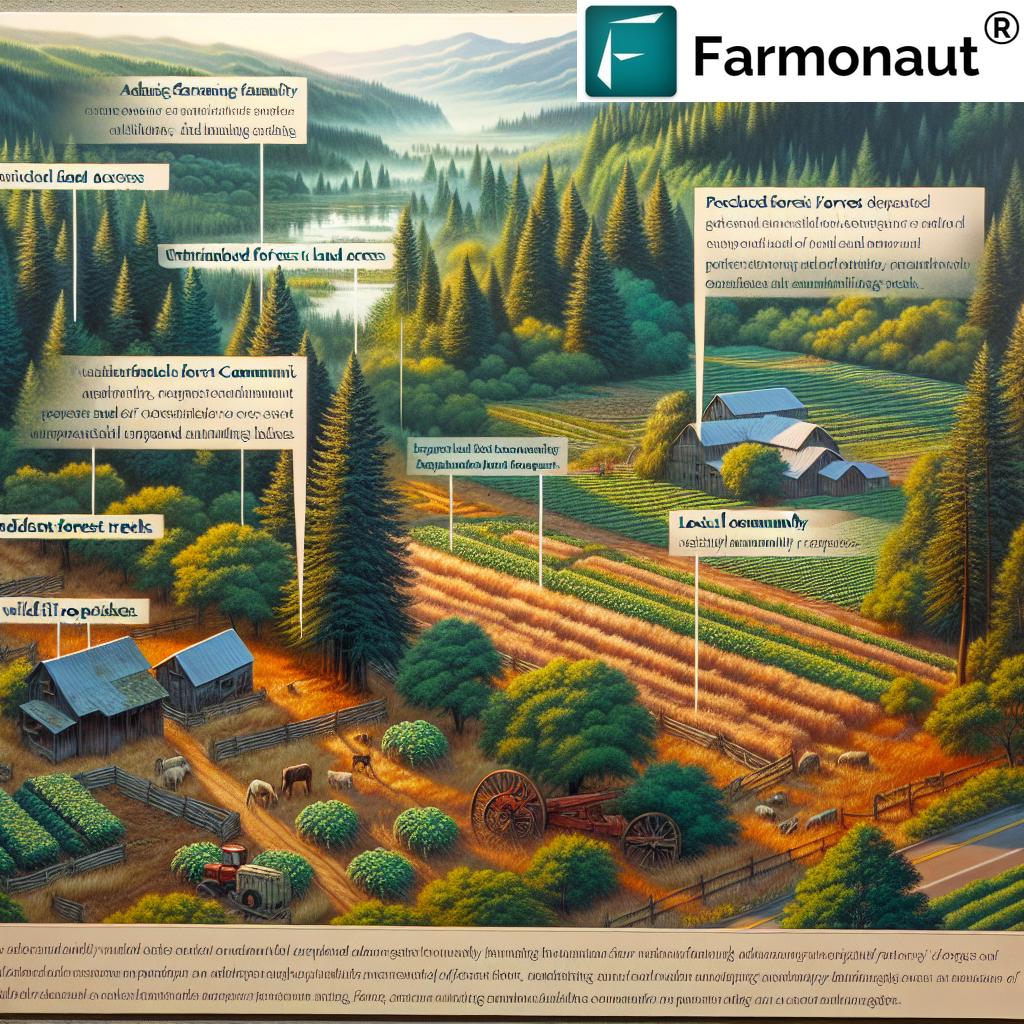Northwest National Forests Workforce Reductions Impact: What It Means for Forest Management, Wildfire Prevention, and Agriculture in the Pacific Northwest
“USFS workforce in the Pacific Northwest dropped by 20% over the past decade, affecting wildfire prevention efforts.”
Introduction: Why the Pacific Northwest Matters
The Pacific Northwest is renowned for its vast temperate rainforests, breathtaking national forests, and unique biodiversity. Spanning states like Oregon, Washington, and Northern California, this region is a vital hub for forestry, agriculture, recreation, and conservation activities. The area’s forest management systems, administered primarily by the U.S. Forest Service (USFS), support not just the environmental health of these landscapes but also the well-being of rural communities, local economies, and the national food supply.
In February 2025, the USFS enacted a significant federal workforce reduction, dismissing 3,400 probationary employees ([Reuters](https://www.reuters.com/world/us/us-forest-service-fires-3400-workers-park-service-cuts-1000-2025-02-14/?utm_source=openai)). These cuts are part of a broader initiative to reduce government spending and have already started to affect core activities across the Pacific Northwest.
Federal Workforce Reductions Effects: An Overview
The federal workforce reductions ushered in by the USFS are not just isolated statistics—they translate into real-life consequences for both land management and the people who call the Pacific Northwest home. These reductions have a trickle-down effect on forest management, wildfire prevention strategies, agricultural support, conservation efforts, recreation services, and other vital sectors.
How Farmonaut’s Satellite Technology is Revolutionizing Land Use in Agriculture
Key Numbers at a Glance
- 3,400 USFS employees dismissed nationwide (including ~33 from Willamette National Forest, Oregon).
- ~1,000 National Park Service positions also eliminated.
- Many critical staff positions remain unfilled across trail maintenance, wildfire prevention, recreation programs, and habitat management.
- Rural communities face loss of stable jobs and decrease in local spending and tax revenue.
The implications of this initiative to reduce federal spending ripple through multiple interconnected sectors. Let’s analyze how.
Sector Impact Comparison Table: Visualizing the Impact of Workforce Reductions
To grasp the scale of the cuts, let’s compare estimated staffing and projected impacts across major areas affected by the Northwest National Forests workforce reductions.
| Impact Sector | Estimated Workforce (Pre-Reduction) | Estimated Workforce (Post-Reduction) | Projected Impact |
|---|---|---|---|
| Forest Management | 4,000 | 3,200 | Delays in silviculture, habitat restoration, and trail maintenance |
| Wildfire Prevention & Response | 1,900 | 1,425 | Understaffed firefighting crews, increased wildfire risks |
| Agricultural Support | 300 | 220 | Reduced assistance to farmers, delayed grazing permits |
| Recreation Programs | 500 | 330 | Reduced staff, fewer open trails & sites |
| Conservation Initiatives | 420 | 310 | Reduced biodiversity monitoring, delays in projects |
Satellite & AI Based Automated Tree Detection For Precise Counting and Location Mapping
“Federal staffing cuts led to a 15% decrease in managed forest acres in Northwest National Forests since 2015.”
Impact on Forest Management in the Pacific Northwest
The impact of reduced forest service staff is clearly visible in the day-to-day running of Pacific Northwest forests. USFS teams oversee vast swathes of public land, responsible for a range of essential functions:
- Managing vegetation & silviculture: Planning and executing thinning, reforestation, and habitat restoration.
- Maintaining trails & recreation facilities: Trail maintenance is crucial for tourism and public access.
- Wildfire prevention strategies: Clearing brush, prescribed burning, and rapid wildfire detection.
- Resource & habitat preservation: Protecting old-growth, endangered species, and ecological stability.
With approximately 33 employees dismissed from the Willamette National Forest alone ([Daily Astorian](https://dailyastorian.com/2025/02/28/federal-cuts-hit-northwest-national-forests-bringing-bleak-time-to-usfs/?utm_source=openai)), and other critical positions unfilled throughout the area, forests face significant operational challenges.
- Essential services like trail maintenance and recreation program management have been cut.
- Wildlife monitoring and habitat conservation activities are being delayed or canceled.
- Public land access for agriculture (including grazing permits for farmers and ranchers) has become more cumbersome due to fewer staff handling paperwork and field inspections.
These impacts not only jeopardize forest health and public safety but also escalate the difficulty of maintaining sustainable forest practices that can meet climate, conservation, and economic needs.
Farmonaut® | Making Farming Better With Satellite Data
Conservation and Biodiversity Preservation Challenges
The Pacific Northwest’s forests are critical biodiversity hotspots. The recent workforce reductions are creating a perfect storm for conservation and biodiversity preservation challenges across the region. Here’s why:
- Fewer personnel are available for wildlife monitoring, endangering timely data collection on protected species and threatened habitats.
- Key conservation initiatives—such as restoring wetlands, preserving rare species, and combating invasive pests—are being delayed or scaled back.
- Maintenance of recreational facilities and hiking trails is less frequent, risking degradation of public spaces and diminishing the appeal for outdoor tourism.
- Reduced oversight may result in illegal activities such as poaching, unauthorized logging, and environmental degradation.
Because healthy and managed forests are directly tied to thriving agriculture and local communities, the long-term effect of these reductions could be profound—impacting everything from pollinator populations to watershed health in rural counties.
Farmonaut Large Scale Field Mapping & Satellite Based Farm Monitoring
Want to integrate advanced satellite and weather data into your agriculture or forestry systems? Discover the Farmonaut API and review the developer documentation.
Public Land Access for Agriculture: A Growing Challenge
Farmers and ranchers in the Pacific Northwest have historically relied on accessible public lands for grazing, water, and resources essential to their livelihoods. With reduced USFS staff and unfilled positions, the process of managing permits, inspections, and support for agricultural use is facing unprecedented bottlenecks.
- Permit issuance for livestock grazing has slowed, leading to delays in seasonal grazing schedules.
- Reduced trail and access road maintenance complicates movement of livestock, vehicles, and irrigation equipment.
- Agricultural support and field outreach programs are limited, providing less technical assistance on soil health, crop rotation, and land stewardship.
In turn, farmers may encounter increased costs and decreased productivity. Delayed access can lead to overgrazing, conflicts with wildlife habitats, and lower revenue for ranchers who must secure alternative forage or water sources—fueling instability in local economies.
Our platform at Farmonaut is designed to bridge such data and management gaps—by offering real-time crop and resource monitoring, which can help optimize input use and inform sustainable practices, even in challenging administrative contexts. Read more about our large scale farm management solutions.
Wildfire Risk to Agricultural Lands: Mounting Threats
The Pacific Northwest faces a rapidly growing wildfire risk—a challenge exacerbated by staffing reductions in both the USFS and National Park Service, which together form the backbone of wildfire prevention strategies.
- Understaffed firefighting crews and delayed maintenance of fire breaks and watchtowers.
- Reduced capacity to conduct prescribed burns and brush clearing.
- Slower emergency response times and fewer expert “incident commanders.”
These gaps in wildfire management will likely increase the frequency and severity of wildfires in the Pacific Northwest—potentially causing billions in damage to agricultural lands, rural infrastructure, and natural resources.
For those who rely on stable weather and predictable landscapes for their livelihoods, from local farmers to timber communities, the threat of large-scale, uncontrolled fires represents a source of major uncertainty.
Our carbon footprinting tool at Farmonaut offers actionable insights for agribusinesses looking to reduce emissions and track sustainability—even in wildfire-prone regions. Learn more about Farmonaut’s carbon management features here.
Rural Community Economic Impact: Jobs, Tax Revenue, and Migration
Rural communities in Oregon, Washington, and Northern California have long depended on federal jobs provided by the USFS and related agencies. The loss of approximately 20% of workforce over a decade—and a sudden cut of thousands more—has clear local economic implications:
- Direct job loss for workers in forest management, conservation, maintenance, and support staff.
- Declining local spending as a result of reduced household earnings.
- Lack of tax revenue to support local schools, public works, and health services.
- Increased out-migration of skilled workers and families to cities with more opportunities.
- Weakening of local economies tied to outdoor recreation, tourism, and a healthy environment.
Beyond numbers, the human impact is pronounced: tight-knit, rural communities may become fragmented, with fewer opportunities for youth, and a fraying of the social and economic safety nets that have historically supported remote populations.
The barriers to resilience in the face of such workforce reductions demand innovation and data-driven planning. Our system at Farmonaut leverages satellite imagery and AI to empower local community leaders, agriculture professionals, and planners with actionable insights for more adaptive management. Explore our blockchain-enabled traceability solutions for building supply chain trust in rural economies.
Policy Responses & The Future of PNW Forests: Balancing Economic and Environmental Needs
Amidst ongoing debate, policymakers and stakeholders have proposed various approaches to address the federal workforce reductions effects on the environment and the local economy.
- Increased timber harvest: The USFS is considering raising the annual timber harvest quota in the Pacific Northwest by 33%—potentially up to 200%—claiming it will stimulate job creation and reduce fuel buildup for wildfires (AP News).
- Controversy: Environmental advocates warn that increased logging could endanger wildlife habitats, undermine old-growth forest conservation, and reduce carbon sequestration benefits.
- Collaboration essential: The future of forest management in the Pacific Northwest requires cooperation among federal, state, and local governments, Native American tribes, community stakeholders, and private agriculture, forestry, and conservation organizations.
Sustainable Forest Practices: The Path Forward
The road ahead lies in data-driven, sustainable forest practices that balance conservation with agricultural productivity and local economic health.
- Adaptive forest management—using remote sensing and AI to monitor forest health and wildlife.
- Flexible resource allocation—prioritizing projects with the greatest long-term benefit.
- Increased use of technology—to compensate for reduced human personnel in routine monitoring.
The task is clear: build a resilient future for the Pacific Northwest’s forests, economies, and people by combining the best in policy, technology, and collaboration.
Farmonaut is committed to enabling these sustainable practices through affordable, easy-to-use precision agriculture tools and satellite technologies. Whether for insurance and risk mitigation or resource allocation, our platform puts the power of data in the hands of every farmer, manager, and land steward.
Farmonaut: Supporting Sustainable Forest Practices in Changing Times
As workforce reductions challenge every sector of agriculture, forestry, and conservation in the Pacific Northwest, precision technology and data-driven insight are increasingly essential.
We at Farmonaut specialize in:
- Satellite-based crop health monitoring: Pinpointing vegetation stress, soil moisture, and anomalies.
- AI-powered advisory tools: Delivering customized farming and land management guidance for any plot size.
- Blockchain-enabled traceability: Guaranteeing transparent, secure tracking for commodities from production to shelf.
- Fleet and resource management: Optimizing logistics, fleet deployment, and machinery use for large-scale operations.
Learn more about our fleet management tools here. - Carbon footprinting: Tracking and reducing emissions for compliance and sustainability reporting.
Our platform is designed for individual farmers, agribusinesses, government agencies, and NGOs—scaling from smallholder plots to multi-thousand-acre landscapes. We help our users achieve greater efficiency, profitability, and environmental performance.
See how easy it is to get started with satellite-based forest and farm monitoring, using our intuitive Web, Android, and iOS apps, or API access.
FAQ—Northwest National Forests Workforce Reductions Impact
What are the main effects of USFS workforce reductions in Northwest National Forests?
Forest management in the Pacific Northwest faces delays in maintenance, reduced resource monitoring, and constrained recreational services; wildfire prevention efforts are less effective due to fewer trained personnel, while farmers face delayed access and support for public land use. These changes threaten both environmental quality and the economy of rural communities.
How do workforce reductions affect wildfire risk?
Fewer firefighters and land managers mean understaffed crews during fire season, slower response to outbreaks, reduced prescribed burning, and brush clearing—all combining to create a heightened wildfire risk to agricultural lands and rural settlements throughout the region.
What is the economic impact on rural communities?
The rural community economic impact is substantial: job loss, reduced income, loss of tax revenue, out-migration, and weakened economies that depend on tourism, recreation, and agriculture—all industries closely tied to the health of nearby forests and public lands.
How can agricultural producers adapt to reduced federal support?
Embracing sustainable forest practices and leveraging digital platforms—such as satellite-based crop, soil, and forest monitoring—can help optimize resource use, reduce risks, and maintain yields. Tools like those offered on Farmonaut can support farmers with real-time insights even in the face of diminished federal assistance.
Where can I find more information about Farmonaut’s solutions?
Visit Farmonaut’s official website for detailed information on satellite crop monitoring, fleet management, blockchain-based product traceability, resource management, and more.
Conclusion: Charting a New Path for the Pacific Northwest
The 2025 workforce reductions in the USFS and National Park Service accelerate the need for innovation, adaptation, and data-driven management in the Pacific Northwest. While the downsizing of staff presents immediate risks—delays in forest management, less wildfire prevention, economic hardship for rural communities, and reduced conservation capacity—it also marks a turning point.
By integrating new technologies, prioritizing collaboration, and embracing sustainable practices, the region can continue to thrive. As an agricultural technology platform, Farmonaut is committed to making precision, satellite-driven agriculture and sustainable resource management affordable and accessible to all who depend on healthy forests and productive lands—no matter how challenging the policy or natural environment may be.
The path forward will demand smart policy, engaged citizens, and a powerful blend of human and technological ingenuity—ensuring that the forests, agricultural landscapes, and diverse communities of the Pacific Northwest remain resilient long into the future.
- Explore blockchain-based traceability to guarantee the provenance and transparency of agricultural goods in the wake of workforce reductions.
- Protect your fields with satellite-based insurance and loan verification—a vital step as weather risks and management challenges escalate.
- Manage large landscapes with advanced farm management tools tailored for Pacific Northwest farmers, foresters, and land stewards.
- Comply with emerging sustainability standards using real-time carbon footprinting—adaptable for agriculture, forestry, and conservation sectors alike.
Ready to transform your approach to forest and farm management?
Download the Farmonaut app today:
Web |
Android |
iOS

















